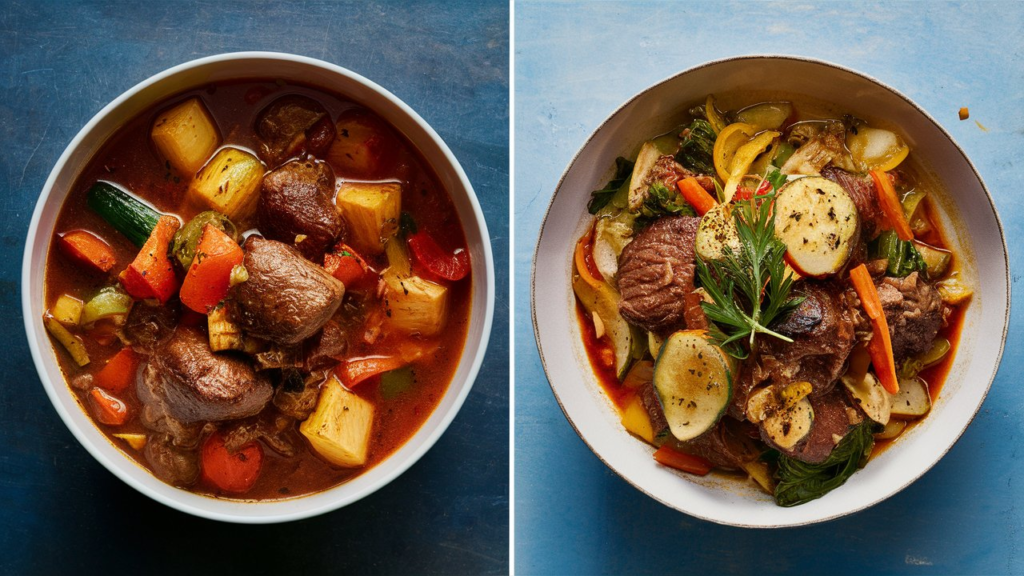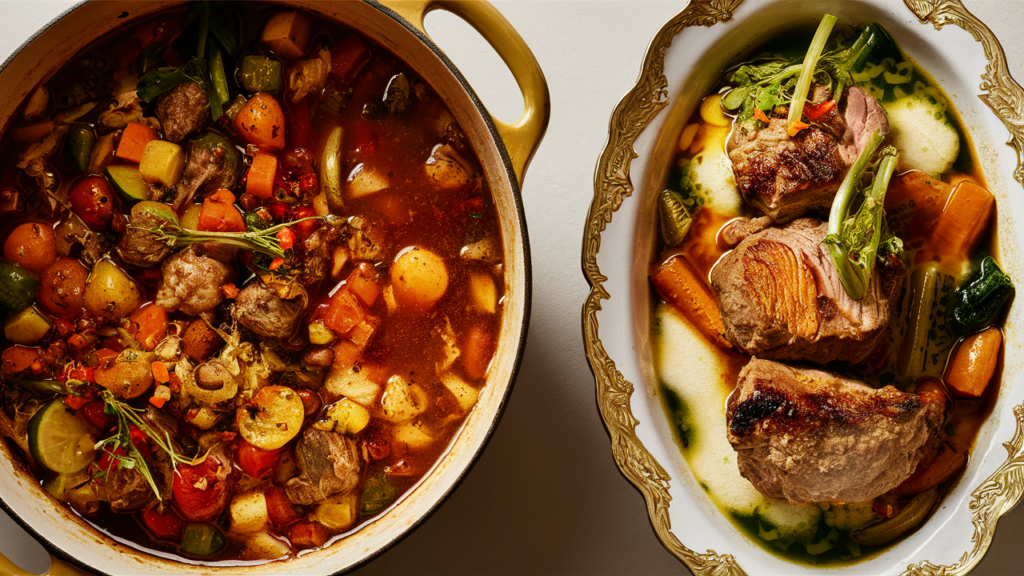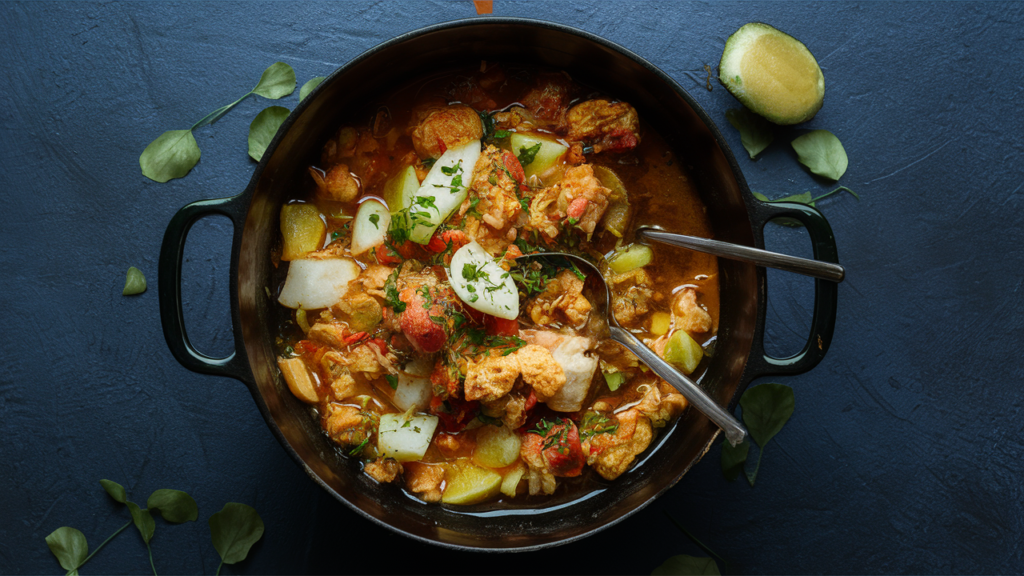In the world of comforting, slow-cooked meals, both stew and fricassee hold prominent places. While they share some similarities in preparation and ingredients, key differences set them apart, offering unique flavors, textures, and culinary techniques. This article explores these differences in detail, providing insights into how each dish is prepared, served, and enjoyed. Understanding these distinctions can enhance your cooking repertoire and allow you to choose the perfect dish for any dining occasion.
Defining the Dishes
What is Stew?
Stew is a hearty, slow-cooked dish known for its robust flavors and versatility. It typically involves:
- Ingredients: A mix of meat (often tougher cuts), vegetables, and sometimes grains or legumes, all cooked in a liquid.
- Cooking method: The ingredients are simmered at a low temperature for several hours, allowing flavors to meld and tough meats to become tender.
- Texture: The result is a thick, hearty dish where the flavors of the components have deeply integrated.
Stews are popular worldwide, with each cuisine bringing its own set of ingredients and spices to the table, reflecting local tastes and culinary traditions.
What is Fricassee?
Fricassee is a French cooking method that offers a refined approach to braising. Key characteristics include:
- Ingredients: Typically uses poultry, but can also include rabbit or veal, along with aromatic vegetables.
- Cooking method: Meat is sautéed without browning and then simmered in a white sauce, often made with a roux and stock.
- Texture: The sauce is creamy and smooth, coating the lightly sautéed meat and vegetables.
This cooking technique emphasizes preserving the natural flavors and textures of the ingredients, resulting in a delicate and aromatic dish.
Direct Comparison
When comparing stew and fricassee directly, the primary distinctions arise in their cooking techniques and the texture of the final dish:
- Browning vs. Sautéing: Stew often begins with browning the meat to develop depth of flavor, whereas fricassee involves gentle sautéing without browning.
- Sauce texture: Stews generally have a thicker, often clear or tomato-based sauce, while fricassee features a creamy, smooth white sauce.
Understanding these foundational differences helps in choosing the right technique for the desired meal outcome.

Ingredients and Preparation
Meat Choices
The choice of meat can significantly influence both the cooking process and the final taste of the dish:
- Stew: Best made with tougher cuts of meat like beef chuck or pork shoulder, which break down and become tender over long cooking periods.
- Fricassee: Commonly uses more delicate meats like chicken thighs or rabbit, which cook quicker and remain tender and moist.
Selecting the appropriate meat is crucial for achieving the desired texture and flavor in either dish.
Vegetable and Aromatics
Vegetables play a vital role in both dishes but are used differently:
- Stew: Root vegetables such as carrots, potatoes, and onions are common, added early to cook thoroughly and contribute to the sauce’s body.
- Fricassee: Lighter vegetables like mushrooms and onions may be used, mainly to enhance the flavor rather than define the dish’s body.
This distinction in vegetable choice and usage underscores the textural and flavor differences between the dishes.
Cooking Techniques
The techniques used in preparing stew and fricassee are distinct and define the dishes:
- Simmering vs. Braising: Stew is typically simmered in a larger quantity of liquid that partly covers the ingredients, while fricassee involves braising in a smaller amount of liquid, leading to a thicker, creamier sauce.
- Time and attention: Stews can be left to cook with minimal attention for hours, whereas fricassee requires more careful monitoring to prevent the sauce from splitting.
These techniques not only affect the cooking process but also the complexity and richness of the dish’s flavors.
Culinary Techniques and Tips
Mastering Stew
Achieving the perfect stew involves mastering several key aspects:
- Layering flavors: Start with browning the meat, then sauté the vegetables, and deglaze with wine or broth to incorporate all the flavorful bits into the stew.
- Slow cooking: Allow the stew to simmer slowly, which melds flavors and tenderizes the meat.
Perfecting Fricassee
To excel in making fricassee, consider the following:
- Control in sautéing: Sauté meat just enough to seal in juices but not brown it, maintaining the dish’s light, delicate flavor.
- Roux-based sauce: Carefully cook the roux to avoid lumps in the sauce, ensuring it is creamy and smooth.
Advanced Tips
For both dishes, advanced cooks might experiment with:
- Incorporating global flavors: Adding spices or ingredients from different cuisines can transform a traditional stew or fricassee into a global dish.
- Technique fusion: Experienced cooks might blend techniques, such as using a roux in a stew for thickness or introducing a slow cooker to fricassee for convenience.
Serving and Enjoyment
Ideal Side Dishes
Both stew and fricassee pair well with various side dishes that can complement and enhance their flavors:
- For Stew:
- Crusty bread or rolls: Perfect for soaking up the rich and hearty sauce.
- Mashed potatoes or polenta: These provide a smooth, creamy texture that contrasts nicely with the robustness of stew.
- Steamed greens like kale or spinach: Adds a touch of freshness and color to balance the heavy flavors.
- For Fricassee:
- Rice or buttered noodles: These mild sides are ideal for highlighting the creamy sauce of the fricassee.
- Bright salads: A crisp, acidic salad can cut through the richness of the dish.
- Roasted vegetables: Lightly seasoned, they enhance the fricassee without overpowering it.
Choosing the right side dishes can elevate the main course, creating a balanced and satisfying meal.

Wine and Beverage Pairings
Selecting the right beverages to accompany your dish can greatly enhance the dining experience:
- With Stew:
- Robust red wines like Cabernet Sauvignon or Syrah: These wines stand up well to the bold flavors of a hearty stew.
- Stout or porter beers: Their deep flavors complement the richness of the stew.
- Rich, full-bodied white wines: For lighter stews, a Chardonnay can be an excellent choice.
- With Fricassee:
- Light to medium-bodied white wines such as Sauvignon Blanc or a light Chardonnay: These wines match the creaminess of the sauce without overwhelming it.
- Sparkling wines: A crisp Prosecco or Champagne can add a delightful contrast to the creamy texture of fricassee.
- Fruity, light red wines: A Pinot Noir can subtly complement a fricassee without dominating its flavors.
Beverage pairings should consider both the main ingredients and the sauce’s richness to complement the dish best.
Tips for Serving
Presentation plays a crucial role in how a dish is perceived and enjoyed:
- Stew:
- Serve in a deep bowl or dish to highlight its hearty and comforting nature.
- Garnish with fresh herbs like parsley or thyme to add a touch of freshness and color.
- Fricassee:
- Use a shallow bowl or plate to showcase the creamy sauce and the tender pieces of meat.
- A light sprinkle of finely chopped herbs or a squeeze of lemon can enhance the visual appeal and add a burst of freshness.
Proper serving techniques can transform a simple meal into an inviting and appealing culinary experience.
Cultural Significance and Variations
Global Variations
Stew and fricassee have been adapted by various cultures, each adding its unique twist:
- Stew Variations:
- Irish Stew: Made with lamb or mutton, potatoes, onions, and parsley.
- Hungarian Goulash: A paprika-laden stew that is rich in spices and flavors.
- West African Peanut Stew: Incorporates peanuts for a creamy texture and unique flavor.
- Fricassee Variations:
- Cuban Fricassee: Often includes citrus and potatoes with a base of tomato sauce.
- Italian Fricassee: Might feature rabbit or lamb and include white wine in the sauce.
- Jewish Fricassee: Typically made with chicken and meatballs in a tomato-based sauce.
These variations highlight how adaptable these dishes are, making them beloved in various culinary traditions.
Historical Context
Understanding the history of these dishes adds depth to their appreciation:
- Stew:
- Historically, stewing is one of the oldest cooking techniques, utilized for its simplicity and efficiency in using available ingredients.
- Stews were common among peasant populations as a way to cook tough meats that were affordable.
- Fricassee:
- Fricassee is considered a refined technique that originated in France. It was a method to create a luxurious dish from simple ingredients.
- Historically, it was often served in royal courts and affluent homes, showcasing its status as a gourmet dish.
These historical insights provide a richer understanding of the dishes, highlighting their roots and evolution over time.

Nutritional Considerations and Health Benefits
Nutritional Profiles
Both stew and fricassee can be nutritious additions to a balanced diet, but their health benefits vary based on ingredients and preparation methods:
- Stew:
- High in protein: Typically made with meat, stews are rich in protein, essential for muscle repair and growth.
- Rich in vitamins and minerals: The variety of vegetables added to stews contribute essential nutrients like vitamins A and C, iron, and potassium.
- Dietary fiber: The inclusion of vegetables and sometimes legumes or grains increases the fiber content, which is beneficial for digestive health.
- Fricassee:
- Lower in fat: Since fricassee often uses leaner cuts of meat and the cooking method involves less fat, it can be a lighter option.
- Rich in protein: Similar to stew, fricassee is a good source of protein, especially when made with chicken or rabbit.
- Calcium and phosphorus: The creamy sauce, often made with dairy products, can provide valuable calcium and phosphorus, which are important for bone health.
Adapting Recipes for Health
Both dishes are versatile enough to be adjusted according to dietary needs or preferences:
- Reducing sodium: Opt for low-sodium stocks or broths and limit added salt to make these dishes heart-friendlier.
- Increasing vegetable content: Add more vegetables to either dish to boost fiber and nutrient intake.
- Choosing lean meats: Opt for leaner cuts or use more poultry in fricassee to reduce the fat content.
These adaptations can help make stew and fricassee healthier without sacrificing flavor.
Health Benefits
Eating stew and fricassee can offer several health benefits, particularly when prepared with an eye towards nutrition:
- Heart health: By using lean meats and incorporating plenty of vegetables, both dishes can be part of a diet that supports heart health.
- Weight management: Both can be part of a balanced diet, providing satiety and essential nutrients without an excess of calories, especially when prepared with minimal added fats.
- Immune support: The rich array of vegetables and herbs can boost the immune system, thanks to their vitamins and antioxidants.
Understanding how to maximize the health benefits of each dish allows you to enjoy these comfort foods even within a health-conscious diet.
Practical Tips for Preparation and Storage
Preparation Tips
Proper preparation can enhance both the flavor and healthfulness of stew and fricassee:
- Marinating meat: For both dishes, marinating the meat can enhance flavor and tenderness.
- Sautéing vegetables: For fricassee, lightly sautéing vegetables before adding them to the dish can enhance their flavor and texture.
- Layering flavors: Building flavors gradually by carefully timing when to add each ingredient ensures that every element of the dish comes through clearly.
Storage and Reheating
Storing and reheating stew and fricassee correctly is essential to maintaining their quality and safety:
- Cooling: Allow the dishes to cool to room temperature before refrigerating to minimize the risk of bacterial growth.
- Storing: Refrigerate leftovers in airtight containers to preserve freshness and prevent contamination. Stew and fricassee can typically be kept for up to three days in the refrigerator.
- Reheating: Reheat only the amount needed to 165°F (74°C) to ensure food safety. Stews can generally be reheated on the stove or in a microwave, while fricassee might require gentle heating to prevent the sauce from separating.
These storage and reheating tips help ensure that your leftovers are just as delicious and safe to eat as when freshly made.
Conclusion
The exploration of stew and fricassee not only enriches one’s culinary knowledge but also provides insights into how these dishes can be adapted for health and enjoyment. By understanding their differences, nutritional content, and the best ways to prepare, serve, and store them, you can fully appreciate these comforting dishes. Whether choosing stew for its hearty, robust qualities or fricassee for its delicate, creamy texture, both dishes offer a satisfying and enriching culinary experience, bridging the gap between tradition and modern dietary considerations.
You can get more recipes from here:

